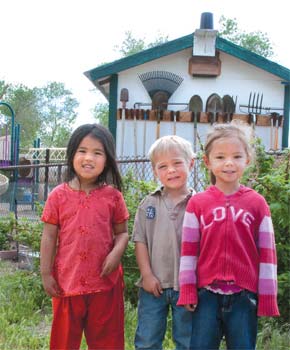edible schoolyard
THE NOT-SO-SECRET GARDEN
Step inside a school with
an extraordinary perspective.
WRITTEN BY JEN HUNTLEY
PHOTOS BY NICHOLETTE CODDING
“Oh, Mom,” Sophie groans, “I know all about ‘Three Sisters.’We did that in our school garden.”
“Three Sisters” is the companion planting method that combines corn, beans, and pumpkin seeds in a mound together. In this Amerindian technique, the corn provides climbing stalks for the beans, the squash leaves shade the root zone and conserve water, and the nitrogen-fixing beans fertilize all three plants. I thought I could teach my 11 year old about this cool idea. As it turned out, she taught me. Again.
School gardens are a growing phenomenon around the country, many inspired by AliceWaters’ project. The effort to connect kids with an intrinsic understanding of where their food comes from means to solve several problems: to improve scientific understanding of ecological systems through observation and hands-on engagement, to build a sense of connection between the kids themselves and the larger world and community around them, and to improve the nutrition of young people by teaching them to grow and appreciate eating intensely local, “real” food.
At Mountain View Montessori, Sophie’s school, the edible schoolyard is a natural extension of educational principles in practice since the school was founded 40 years ago. As in many Montessori schools, lunches are student-run enterprises, with committees responsible for making and selling a different meal each day.Worm bins in every classroom speed the composting of lunch and other biodegradable waste.With food already an integral component of the school’s community and curriculum, building a garden to provide the ingredients for those meals was an obvious extension.
Principal Mary Levy recognized the opportunity to extend the school’s “whole child” focus. Edible plants are grown throughout the campus: Grapevines trail the railings, fruit trees shade the patio, herbs and currant bushes are built in throughout the campus landscaping.
Cheryl Nowak, a parent and University of Nevada, Reno researcher, organizes the garden planting around age-appropriate capabilities and providing ingredients for the lunch programs. Younger children plant larger vegetables such as potatoes and onions, while older kids, with finer dexterity, plant the peas and carrots. Adolescents (grades 7 – 8) learn scientific principles in the hydroponic greenhouse while raising salad greens for school lunches. Flowers provide classroom decoration and the material for botanical studies in grades 4 – 6.
As students, teachers, and parents work to build the many benefits of school gardens into their campus communities, Mountain View Montessori’s edible schoolyard provides a working demonstration of the possibilities for Northern Nevada schools.
Jen Huntley is a scholar, writer, and consultant on educational excellence and sustainable communities. One of her daughters is a Mountain View Montessori graduate, and her other daughter still attends the school.


